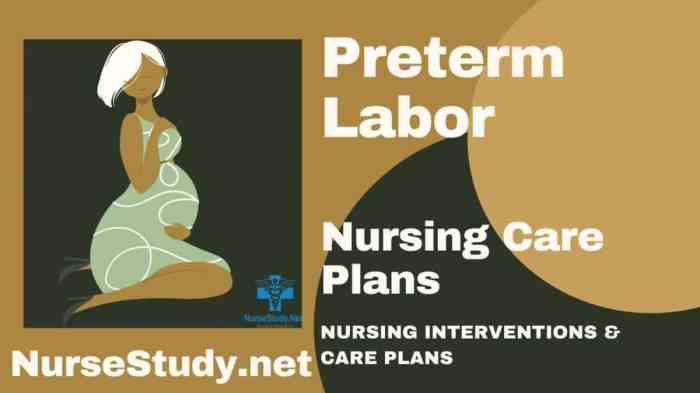RN maternal newborn preterm labor, a critical concern in nursing, poses significant challenges and requires specialized care. Understanding the risk factors, causes, and management strategies is paramount for nurses to provide optimal care and improve outcomes for both mothers and infants.
This comprehensive guide delves into the complexities of preterm labor, exploring its prevalence, potential complications, and the role of nurses in assessment, diagnosis, and management. By gaining a deeper understanding of this topic, nurses can enhance their ability to provide compassionate and evidence-based care, contributing to improved maternal and newborn health.
RN Maternal Newborn Preterm Labor Overview

Preterm labor, defined as labor that occurs before 37 weeks of gestation, is a significant concern in the field of nursing. It accounts for a substantial proportion of infant morbidity and mortality, and can have long-term consequences for both the infant and the mother.
Preterm labor is associated with various complications and risks, including:
- Low birth weight and premature birth
- Respiratory distress syndrome
- Intraventricular hemorrhage
- Necrotizing enterocolitis
- Developmental delays
- Increased risk of chronic health conditions, such as cerebral palsy, vision and hearing impairments, and respiratory problems
According to the World Health Organization (WHO), approximately 15 million babies are born preterm each year, accounting for 11% of all live births globally.
Risk Factors and Causes of Preterm Labor

Numerous risk factors have been identified that contribute to preterm labor, including:
- Maternal age (younger than 18 or older than 35)
- Previous preterm birth
- Multiple gestation (carrying twins or more)
- Uterine abnormalities (e.g., cervical incompetence)
- Placental abnormalities (e.g., placenta previa)
- Maternal infections (e.g., urinary tract infections, bacterial vaginosis)
- Chronic health conditions (e.g., diabetes, hypertension)
- Substance use (e.g., smoking, alcohol consumption)
- Stressful life events
- Low socioeconomic status
The exact causes of preterm labor are often unknown, but potential mechanisms include:
- Uterine overdistension
- Premature rupture of membranes
- Inflammatory response
- Hormonal imbalances
Assessment and Diagnosis of Preterm Labor
Clinical signs and symptoms of preterm labor include:
- Uterine contractions occurring more frequently than every 10 minutes
- Pelvic pressure or a feeling of fullness
- Low back pain
- Abdominal cramping
- Vaginal discharge or spotting
Diagnosis of preterm labor involves:
- Physical examination
- Fetal monitoring
- Laboratory tests (e.g., cervical cultures, fetal fibronectin testing)
Early detection and diagnosis of preterm labor are crucial for improving outcomes.
Management and Treatment of Preterm Labor: Rn Maternal Newborn Preterm Labor
Treatment options for preterm labor aim to stop or slow down labor and prolong pregnancy.
- Tocolytics:Medications that inhibit uterine contractions, such as terbutaline or nifedipine
- Lifestyle modifications:Bed rest, hydration, stress reduction, and avoidance of strenuous activity
The choice of treatment depends on the severity of preterm labor, gestational age, and the mother’s and infant’s health status.
Nursing Care for Women Experiencing Preterm Labor
Nursing interventions for women experiencing preterm labor include:
- Providing emotional support and reassurance
- Educating about preterm labor, treatment options, and potential outcomes
- Counseling on lifestyle modifications
- Monitoring fetal well-being through fetal monitoring and assessing maternal vital signs
- Managing complications, such as pain, infection, and dehydration
Nurses play a vital role in providing holistic care and support to women experiencing preterm labor.
Long-Term Outcomes and Prevention of Preterm Labor
Long-term outcomes for infants born prematurely can vary depending on the severity of prematurity and the presence of complications.
Potential long-term outcomes include:
- Developmental delays
- Chronic health conditions (e.g., cerebral palsy, vision and hearing impairments, respiratory problems)
- Increased risk of adulthood obesity, cardiovascular disease, and mental health disorders
Strategies for preventing preterm labor include:
- Preconception care (e.g., optimizing maternal health, addressing risk factors)
- Healthy pregnancies (e.g., regular prenatal care, avoiding smoking and alcohol consumption)
- Lifestyle changes (e.g., stress reduction, maintaining a healthy weight)
Women at high risk of preterm labor may benefit from additional interventions, such as cervical cerclage or progesterone therapy.
Q&A
What are the common risk factors for preterm labor?
Risk factors include previous preterm birth, multiple pregnancies, maternal age (younger than 18 or older than 35), certain medical conditions (e.g., infections, uterine abnormalities), and lifestyle factors (e.g., smoking, alcohol use).
How is preterm labor diagnosed?
Diagnosis involves assessing clinical signs (e.g., uterine contractions, cervical changes) and performing tests (e.g., fetal monitoring, laboratory tests) to rule out other causes of symptoms.
What are the treatment options for preterm labor?
Treatment may include medications (e.g., tocolytics) to stop contractions, lifestyle modifications (e.g., bed rest, hydration), and interventions to manage underlying causes (e.g., treating infections).
What is the role of nurses in caring for women experiencing preterm labor?
Nurses provide emotional support, education, and counseling; monitor fetal well-being; manage complications; and advocate for the well-being of both mothers and infants.
What are the potential long-term outcomes of preterm labor?
Premature infants may face increased risks of respiratory problems, developmental delays, and other health issues, which can have long-term implications for their health and well-being.